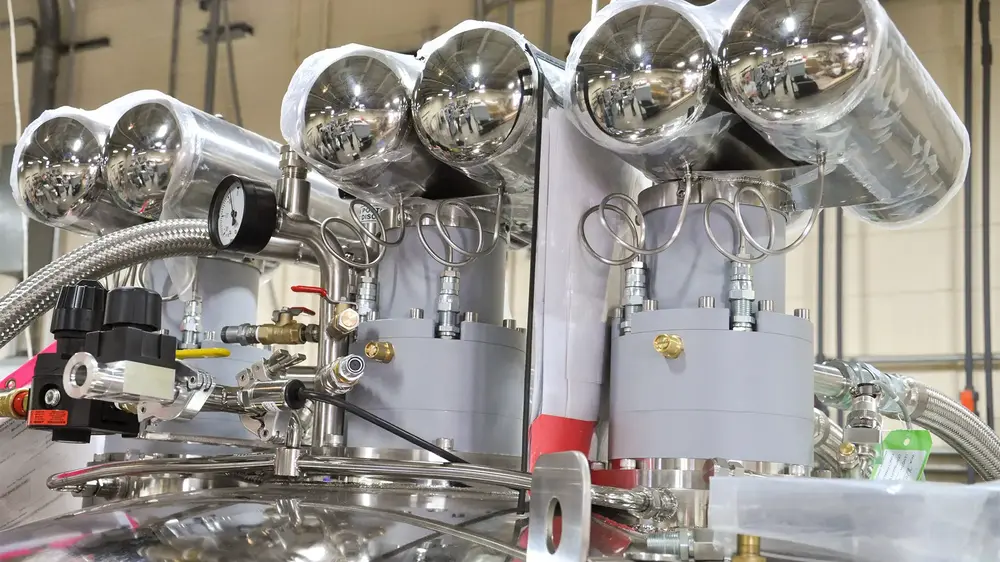Introduction
Liquid helium cooling is a specialized cryogenic technique where helium is used in its liquid state to reach extremely low temperatures, specifically in the range of 4.2 Kelvin (−268.93°C) and below. These temperatures are close to absolute zero (0 K), the point where all classical molecular motion ceases. Liquid helium is indispensable in applications requiring superconductivity, quantum coherence, and noise-free environments, where even small amounts of heat would affect performance or data accuracy.
Physical and Chemical Properties of Liquid Helium:
- Boiling Point:
Helium becomes a liquid at 4.2 K at atmospheric pressure. This makes it one of the coldest substances available in a liquid state. - Inert Nature:
Helium is chemically non-reactive, so it doesn’t corrode or interact with other materials. This makes it ideal for cooling sensitive scientific instruments. - Superfluidity (Below 2.17 K):
Below a certain temperature, helium enters a quantum state known as superfluid helium (He II). In this state:- It can flow through microscopic pores and even climb walls.
- It has zero viscosity and can transfer heat with incredible efficiency due to a phenomenon called second sound (a wave of temperature).
- Low Density & High Diffusivity:
Being the second lightest element, helium gas expands quickly and can easily escape containment if not managed carefully. - High Thermal Conductivity:
Especially in its superfluid state, it conducts heat much more efficiently than many metals.
Why is Liquid Helium Used for Cooling?
Achieving Ultra-Low Temperatures
- Helium’s boiling point is lower than all other gases, allowing systems to operate close to 0 K, which is essential in many physics and engineering fields.
Enables Superconductivity
- Superconductors are materials that lose electrical resistance at low temperatures.
- Most conventional superconductors need temperatures at or below 4 K—achievable only with liquid helium.
Chemically Safe and Non-Flammable
- Being inert, helium doesn’t burn, explode, or chemically react, making it safe to use around sensitive electronics and medical devices.
Stable and Non-Toxic
- Even in confined environments, helium poses minimal health hazards compared to other cryogens like liquid hydrogen or nitrogen.
Real-World Applications of Liquid Helium Cooling:
MRI Machines (Magnetic Resonance Imaging):
- MRI uses powerful superconducting magnets that need to be cooled below their critical temperature.
- Without helium, these magnets would lose their superconductivity and stop functioning efficiently.
- Typically, hundreds of liters of liquid helium are used to maintain stable operations over long periods.
Particle Accelerators and Research Facilities (e.g., CERN):
- Superconducting electromagnets guide and accelerate particles at nearly light speed.
- Liquid helium is used to keep these magnets in a superconducting state, reducing electrical resistance to near zero and enabling high precision.
Quantum Computers:
- Qubits (quantum bits) are extremely sensitive to temperature and environmental noise.
- Liquid helium is used to maintain stable temperatures for quantum processors, sometimes as low as millikelvins (thousandths of a Kelvin).
- This ultra-cold environment helps in reducing thermal noise, maintaining coherence, and improving computational accuracy.
Space Telescopes and Infrared Sensors:
- Space-based infrared telescopes like Spitzer Space Telescope and James Webb use helium to cool infrared sensors.
- Without cooling, the sensors would pick up their own heat instead of distant cosmic sources.
Low-Temperature Scientific Research:
- Liquid helium enables the study of quantum effects, low-temperature superconductors, Bose-Einstein condensates, and superfluidity.
- It’s vital in laboratories conducting fundamental physics experiments.
Methods of Using Liquid Helium in Cooling:
Bath Cooling:
- The object or system is immersed in a pool of liquid helium, allowing direct contact and efficient heat extraction.
- Common in superconducting magnet cooling.
Helium Flow Systems:
- Liquid helium is circulated through pipes or channels to cool specific regions or components.
- Often used where direct immersion isn’t practical.
Mechanical Cryocoolers:
- Devices like Gifford-McMahon (GM) or pulse-tube coolers use helium gas in closed-loop systems to cool without continuous liquid helium usage.
- Helps reduce the need for frequent refills and helium loss.
Helium Recondensers:
- Captures evaporated helium gas, recondenses it back into liquid, and recirculates it, minimizing wastage and cost.
Challenges in Using Liquid Helium:
Cost:
- Helium is rare and expensive, especially in liquid form.
- Its extraction from natural gas fields is energy-intensive, and global supply is limited.
Boil-Off Losses:
- Liquid helium boils rapidly when exposed to ambient temperatures, leading to constant evaporation unless well-insulated.
- Dewar flasks and vacuum jackets are used to minimize losses.
Complex Storage:
- Requires special containers with multiple insulation layers to prevent heat transfer.
- Transport and storage need expert handling to avoid helium loss or safety issues.
Limited Global Supply:
- Helium is a non-renewable resource on Earth.
- Conservation and recycling systems are increasingly important in modern systems.
Conclusion
Liquid helium cooling stands at the forefront of ultra-low temperature applications, enabling breakthroughs in science, medicine, and quantum technology. Its exceptionally low boiling point and inert nature make it ideal for superconducting systems, MRI machines, particle accelerators, and quantum computers—where maintaining near-absolute-zero conditions is non-negotiable. Despite its advantages, the high cost, limited availability, and complex handling requirements present challenges. However, advancements in helium recovery systems, closed-loop cooling, and high-temperature superconductors are helping reduce dependence and optimize performance.

